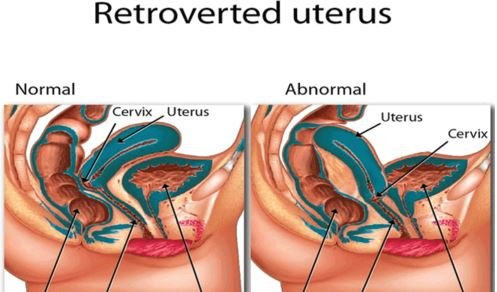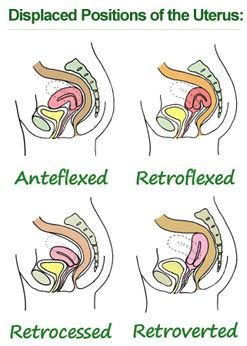Retroverted Uterus
What is a Retroverted Uterus?
Retroverted uterus is also referred to as tipped uterus, uterine retrodisplacement, or retroflexed uterus in which the uterus is tipped backwards so that it points towards the rectum in place of having directed towards the belly.

Generally, a woman’s uterus is a highly muscular, distensible reproductive organ that has the capacity to expand freely to support a growing fetus during the pregnancy state. Many women are somehow worried of having a retroverted uterus concerning their pregnancy, but it does not affect a woman’s fertility nor does it intervene with pregnancy.
Retroverted uterus affects 20% of all women around the world and could cause some painful symptoms or indicate a primary health disorder.
What are the Symptoms of a Retroverted Uterus?
Most women who have retroverted uterus experience no symptoms at all but if symptoms are manifested, two will commonly occur and these symptoms are the result of force being exerted by the retroverted uterus on the ligaments surrounding the tailbone and on the rectum. These are:
- Pain during menstrual periods or dysmenorrhea
- Pain throughout a sexual intercourse
- A feeling of discomfort felt by the women when she is positioned on-top during a sexual intercourse
Other rare symptoms that may occur with a retroverted uterus include:
- Fertility problems
- Pain on the lower back part
- Loss of bladder control
- Pain felt during the use of tampons
- Urinary tract infection increases in number
What Causes a Retroverted Uterus?
A woman with a tipped uterus or any other position is born with it. There are no preventions for this condition. Any normal acts will not change the position of the uterus although the angle can be shifted. Some possible causes of a retroverted uterus include:
- Adhesions – This is a band of scar tissue that binds two different anatomic surfaces together. Surgery of the pelvis could generate adhesions to develop, which later on pulls the uterus into a tipped position.
- Fibroids – These are tiny benign lumps that can make the uterus receptive to tipping backwards.
- Natural variation – For most cases, the uterus typically tilts forward as the woman grows older but sometimes, this does not happen and the uterus will remain retroverted backwards.
- Endometriosis – The endometrium is the mucous membrane that lines the uterus. Endometriosis is the development of endometrial cells outside the uterus. The cells that grew can cause a tipped uterus by sticking it to other pelvic structures.
- Pregnancy – A woman’s uterus is composed of connective tissue called ligaments to hold it in place. Pregnancy can make excessive demands on these ligaments and stretch it too much allowing the uterus to tip backwards. For most women, the uterus returns back to normal after childbirth, but sometimes it does not.
Diagnosis
If a woman is experiencing a painful sexual intercourse with her partner or other symptoms related with a retroverted uterus, an appointment to the physician should be made for proper examination. Some of these cases are somewhat mistaken for a growing fibroid or a pelvic mass.
The physician will then perform some tests to diagnose the condition and to find out if there are other conditions that cause the retroversion of the uterus like fibroids or endometriosis.
Diagnosis commonly consists of:
- Pelvic examination – Some women only discover that they have a tipped uterus during this test.
- Abdominal ultrasound – The purpose of this test is to see the accurate position of the uterus.
- A rectovaginal exam – This is to differentiate a retroverted uterus from a mass.
How is Retroverted Uterus Treated?
Treatment is not necessary most of the time but if there are other problems that lead to the disease, it should be treated. Options in treating the condition can include:
- Exercises – If the motion of the uterus is not interfered by fibroids or endometriosis, and if the physician could reposition the uterus in a manual manner through the pelvic examination, exercises might help. Nonetheless, the medical profession is still uncertain whether or not pelvic exercises are beneficial as a long-term treatment for the problem since in most cases, the uterus tips backward again.
- Underlying condition treatment – Problem with endometriosis can be managed through hormonal therapy with patients.
- Pessary – This is a small plastic or silicone device that could be positioned permanently or temporarily to steady the uterus into a forward lean. Pessaries are not highly recommended because of the increased risk of acquiring inflammation and infection. Another reason why it is still not advisable is that sex is still painful, and it could get worse with pessary due to the discomfort that can be felt by both.
- Treatment for incarcerated uterus – This involves the insertion of a urinary catheter in order to empty the bladder, hospitalization, and a sequence of exercises to free the uterus.
Pictures



References:
Retroverted Uterus – Women’s Health Information at http://www.womens-health.co.uk/retrover1.html
http://www.betterhealth.vic.gov.au/bhcv2/bhcarticles.nsf/pages/Retroverted_uterus
https://www.nlm.nih.gov/medlineplus/ency/article/001506.htm
Barton-Smith P, Kent A (2007 Feb). Asymptomatic incarcerated retroverted uterus with anterior sacculation at term. Int J Gynaecol Obstet. 96(2):128.
Ozel B (2005 Aug). Incarceration of a retroflexed, gravid uterus from severe uterine prolapse: a case report. J Reprod Med. 50(8):624-6.
Yang JM, Huang WC (2004 May). Sonographic findings in acute urinary retention secondary to retroverted gravid uterus: pathophysiology and preventive measures. Ultrasound Obstet Gynecol. 23(5):490-5.
